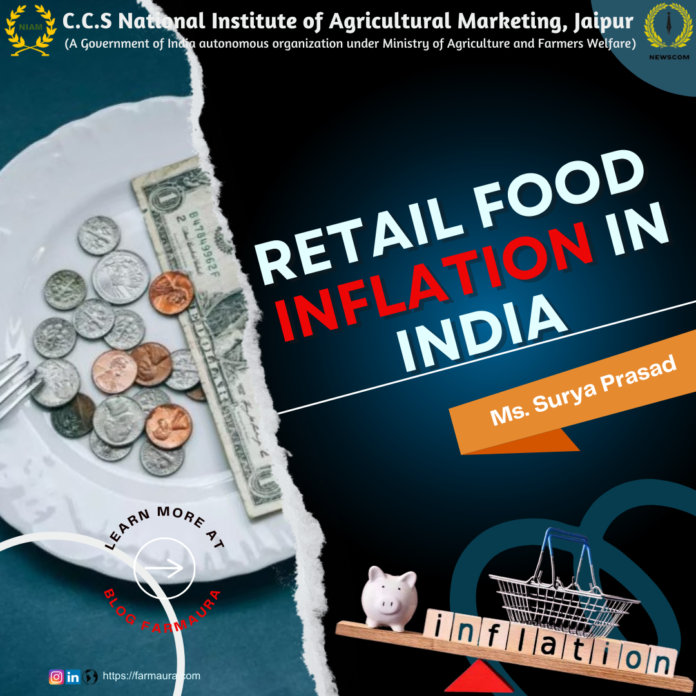India’s inflation and economic growth are undergoing risk from the rise in oil prices caused by disruptions in the Red Sea, highlighting the need to diversify trade routes which was suggested earlier by our Finance ministry. India’s trade of agricultural commodities, textiles, chemicals, capital goods, marine and petroleum products may be affected due to the disruptions and affect the price competitiveness of exports.
Whether the crisis impacts the value of exports in the next financial year runs from April to March. The inflation outlook for the upcoming months is positive, as a pick-up in summer crop sowing is expected to help curb food prices. India’s retail inflation eased slightly to 5.09% in February, However, the central bank continues to focus on lowering inflation to the 4% target.
Status of Agricultural Produce
Annual food inflation in India was 8.66% in February 2024, slightly higher than 8.3% in January, mainly due to prices for vegetables (30.3% vs 27%), while cost slowed for pulses (18.9% vs 19.5%), spices (13.5% vs 16.4%) and fruits (4.8% vs 8.7%) and continued to fall for oils and fats (-14% vs -15%).

How India Tackles Food Inflation?
Recently RBI again made statements that inflation is going to be on the watch list of the government for next one year that is the coming fiscal is going to be again a year where inflation rates of a lot of key commodities is going to be a cause of concern and government is keeping a close watch. It found that retail inflation based on CPI (Consumer Price Index) currently at 5.09 percent was on a decline since December.
As RBI is right about inflation that it is something to watch and globally food inflation has been a matter of a concern but as a matter-of-fact India has been able to manage its food inflation well when it compares to other geographies. It starts with a proactive monitoring and then taking policy decisions quickly and in case of commodities, timing is the key and our governance framework from the interministerial committee of secretaries to the committee of secretaries headed by the cabinet secretary to the group of ministers headed by honourable home ministers, this should work fast.
Rationale Behind the onion exports ban
India has imposed a ban on exports of onions until 3rd March 2024, following a surge in domestic prices to Rs 40/kg due to crop damage from unseasonal rainfall in Maharashtra. This move is anticipated to result in a huge drop in onion prices in January. Recent surveys by central government officials explains the damage caused by the rainfall, and while export demand from Bangladesh had initially supported prices, traders expect a decline once kharif onions flood the market in January
This is a segment of the trade which prices in India free on board (FOB) were like $340 but in overseas markets including Bangladesh, Malaysia and Sri Lanka they were at about $11,000. But for us domestic supplies are very important as to maintain the availability in the domestic market. Onion prices in India retail have regular checks every day to keep limit at 30-35 rupees, this is possible only because of the policy interventions like ban of export so that for the domestic consumer’s availability and affordability is ensured.
Even today we check the retail prices many mandies, Lets take Nasik mandies, it’s in the range of 13 to 15 rupees so of good quality onions so 15 rupees fetches a good price for the farmer so farmer is not being short change, it’s just the differential between the overseas price and the domestic fob that some traders obviously would suffer even though, main focus should be on domestic consumer. Government has announced procurement of 5 lakh tons for the government buffer. Procurement would be done in 15-20 days from now when the moisture level of the onion which comes from the farm goes down, that 5 lakh tons will be bought through NAFED and NCCF from the domestic farmer it gives further comfort level to the farmer that any kind of crisis in terms of prices crashing will not happen.
Conclusion
The prices of commodities have two dimensions one is supporting the farmer the other is to make sure that the consumer can get goods both in an affordable way and they must be available.
So, availability and affordability are two key paradigms on which India must focus. Pulses continue to be an area which caters to a lot of India’s consumption is dependent on Imports and Department of consumer affairs is the one who negotiates the prices ensures that there is enough availability available in the country for consumption so that there’s no shortage, If we look at the pulses basket, Indians consume about 280 lakh tons and we produce about 270- 275 lakh tons so there is this difference. However, individual pulse wise data like tur dal or Arhar dal it is name known by these two names comprises about 34 lakh tons but consumption is about 44 lakh tons so this deficit of 10 lakh tons has to be met through Imports so we import from East African countries and Myanmar thereby constantly have to watch the production in these two geographies and ensure that the flow of imports is seamless and without any difficulties to ensure the availability within the country.
Therefore, a consistent import policy, a seamless flow of imports through our ports and keeping an eye on the overseas production that has to be done almost on a daily basis.




